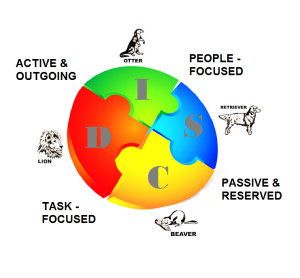 A Style of Influence personality profile can improve your team communication and provide a deeper understanding of yourself and others.
A Style of Influence personality profile can improve your team communication and provide a deeper understanding of yourself and others.
No group ever complained that their team communication was too good!
In fact, most of the workplace interpersonal conflicts you may have seen or been part of are likely the results of relationships between people who simply do not have an appreciation for the personality profile or strengths of their coworker.
We all have a style of influence – a way that we prefer to deal with information, emotions, goals, or details – and when we experience difficulties with another person it may simply be a symptom of having a different personality profile.
To improve your team communication, the first step is making your team aware of their own personal style of influence – and then you can use their personality profile to point out potential conflicts or identify individual strengths on your team that have not been taken advantage of.
If you wonder how a different personality profile can damage or improve team communication and morale, consider this example.
Having worked with numerous teams, I have often enjoyed asking the individuals on teams from various fields (athletic, corporate, and academic) a couple of very simple questions… and these two questions have always provided a tremendously interesting and consistent response.
The first question I ask people on teams I work with is “What do you love about your job / role in the organization?”
Almost invariably, people respond that they love the people that they work with, the people that they work for, and/or the people that they are working to help. Nurses love their patients and coworkers, teachers love their students and being around fellow teachers.
The greatest joy your teammates get is being with you and the people on your team.
But the second question I like to follow up with and ask teams is “What about your job in the organization makes you crazy?”
And guess what the number one answer is?
People!
The same teammates who love being on your team because of the great people also cannot stand being around “people who…” or “that guy!”
But what I have also found is that the “sandpaper person” in your group, whoever it might be, is often someone that you do not fully understand.
Completing a personality profile and identifying the reasons why you and your teammates act the way you do, or process things in a certain preferred fashion, can be a significant first step in beginning to improve team communication, rapport, and relationships.
You may have heard of the DiSC or MBTI® assessments, which attempt to identify how someone sees him or herself in regards to their environment. These do not measure intelligence or skill, but do provide insight into personality types.
The simple and easy to understand “animal types” inventory developed by Gary Smalley is based on the DiSC assessment, and is a fun and easy way for people to begin to develop an appreciation of their own personality profile as well as that of their teammates.
For organizations interested in going deeper and looking to use that information to place people in more productive roles based on strengths, though, the Style of Influence assessment is a comprehensive and powerful instrument.
While the DiSC test identifies your “strongest characteristic trait”, the Style of Influence is a more integrated assessment tool that places you on a sliding scale in four categories to explain your preferred way to engage with information or influence others.
Everyone enjoys learning more about themselves – but you will be surprised to learn how much team personality types influence teamwork.
If you are dealing with a group that needs to improve team communication, a personality profile can be used successfully as a conflict resolution tool. Consider the benefit of a personality profile for the members of your team as part of your next annual meeting or as part of your next teambuilding event.
The more you understand about yourself and your teammates, the better you will e able to interact and work together!
If you liked this article, you will want to request free access to Sean’s Teamwork Toolbox – over 50 useful handouts and activities for smart team leaders!
